trenchless products
 THOMPSON, CONNECTICUT USA, August 31, 2017:
THOMPSON, CONNECTICUT USA, August 31, 2017:
Numa, the world’s leading drilling technology provider, is proud to announce the addition of Mudlogic as its new distributor in Australia, New Zealand, Papua New Guinea, Indonesia, Philippines, and Malaysia. Mudlogic supplies drilling fluids, muds, and specialty products to the mining, water well, foundation, construction, tunneling, and HDD industries in Australia and SE Asia.
Mudlogic offers a growing line of drilling products combined with on-site technical support to help customers in the region reduce overall cost of operation. Mudlogic is renowned for its expertise developed through years of experience working in the field with customers to support their needs.
“Mudlogic keeps abreast of advancements in new technology and changes in the industry so they can provide the region with the best products and advice for the task at hand,” said Ralph Leonard, President of Numa. “Numa is very excited to have teamed with Mudlogic who takes great pride and care in the product line and service they deliver”.
Geoff Wood, General Manager of Mudlogic added, “We are delighted to join the Numa family of distributors. Numa’s world’s leading DTH hammers and bits are the perfect solution for customers in our region looking for the best way to handle any rock drilling needs.”
For more information please visit their website mudlogic.com.au
ABOUT NUMA
Numa provides the world’s leading drilling technology with over 110 DTH Hammer and Bit products serving 11 different industries. Our products are designed to drill vertical, horizontal, and reverse circulation holes from 3½ to 48 inches (89 – 1219 mm) in diameter in hard rock, overburden, or loose strata formations. Having customers in 105+ countries, we have built our customer-centric reputation on providing the highest value in products, performance, and personal service available in the rock drilling industry.
ABOUT MUDLOGIC
The Mudlogic Group is an independent, privately owned specialty drilling fluid and consumables supplier. We have a focus on the Australian and South East Asian region with strategically located offices in Brisbane, Perth, Kalgoorlie and Singapore. Our systems, combined with our on-site technical support and our commercially competitive pricing, will reduce overall cost of operation. We are committed to enabling better processes, offering innovative products for all drilling and special foundation applications as a genuine alternative supplier. This all means that we do better and go further to not only meet, but exceed our customer expectations.
Industry News, trenchless people
 Ve Group now sells and services Vermeer underground construction equipment
Ve Group now sells and services Vermeer underground construction equipment
PELLA, Iowa, August 29, 2017 – Vermeer Corporation expands its South America dealer network with the addition of Medellín, Colombia, based Ve Group. With the addition of Vermeer underground construction equipment, Ve Group will be able to provide its Colombian customers with high-quality construction equipment, as well as aftermarket parts and service support.
“Ve Group is committed to its customers,” said Tony Briggs, vice president – sales & distribution at Vermeer. “Dealer Principal Santiago Durango has an established track record and in-market experience in the pipeline installation, maintenance and rehabilitation markets. He puts his customers’ needs first. We are confident he and everyone at Ve Group will do an excellent job of representing Vermeer.”
Over the last 10 years, Ve Group has been instrumental in establishing trenchless technology best practices in South America and has formally trained more than 1,300 people at universities and on jobsites. The team at Ve Group has provided support and onsite expertise on many of the largest underground projects in Colombia and surrounding countries. Santiago is also a founding member of ICTIS, the Colombian International Society for Trenchless Technology chapter.
“Our partnership with Vermeer will be good for contractors in Colombia,” Durango said. “We’ve always been committed to providing our customers with the best solutions at the best value, and the Vermeer utility installation products exceed our high standards. I’ve had the opportunity to work with the team at Vermeer in various roles throughout my career, and I know they will do a great job of working with customers and us. We’re excited to be representing the Vermeer brand.”
To learn more about Ve Group products and services, visit vedelivers.com.
To learn more about Vermeer Corporation, products, the dealer network and financing options, visit vermeer.com.
trenchless people
 Molly & Matt Go to Mears!
Molly & Matt Go to Mears!
After meeting at NASTT’s South Central Regional Chapter event in Arlington, Texas, Sewer Division Director at Mears Group, Inc, Matt Wilkin, invited NASTT Membership Manager, Molly Gallagher, on her very first jobsite visit! Fortunately Matt was going to be in Cleveland, Ohio in early August and they set a date to meet up. Preparations began as Molly had to purchase her first pair of steel toed boots! “Safety First” is the message that Matt continuously drove home, as the mission statement at Mears is to safely deliver innovative, efficient and high quality construction solutions to the energy distribution industry by:
- Providing best value services to our customers
- Developing and retaining the best people in the industry
- Committing to the highest safety and quality standards
- Investing in the best equipment and technology available
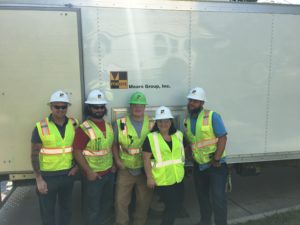 Mears has more than $50 million invested personal safety equipment and training in past two years, including AED equipment on their trucks and other locations totaling 5,000 AEDs purchased with training provided to all employees.
Mears has more than $50 million invested personal safety equipment and training in past two years, including AED equipment on their trucks and other locations totaling 5,000 AEDs purchased with training provided to all employees.
Molly met several crew members on two job sites and was invited back anytime.
Molly added, “I want to offer a sincere thank you to Matt Wilkin and Mears for allowing me to see the inter-working of your crews, staff and facility. It was an experience I won’t ever forget. I should have asked to keep the hardhat and stylish vest!”
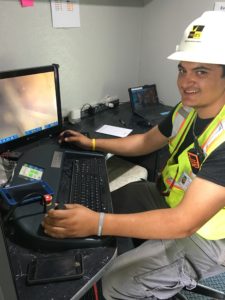
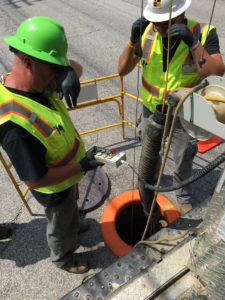 Click here for more information on NASTT Corporate Member, Mears Group, Inc.
Click here for more information on NASTT Corporate Member, Mears Group, Inc.
trenchless people
 Tempe, Ariz. – Engineering undergraduates moving into a new Arizona State University residence hall this week will find themselves immersed in a collaborative, technology-laden living and learning community built specifically for engineers.
Tempe, Ariz. – Engineering undergraduates moving into a new Arizona State University residence hall this week will find themselves immersed in a collaborative, technology-laden living and learning community built specifically for engineers.
The Fulton Schools Residential Community at Tooker House is a 1,600-person, co-ed residential community for undergraduate students in ASU’s Ira A. Fulton Schools of Engineering. The “dorm built for engineers” features on-site digital classrooms, state-of-the-art makerspaces complete with 3D printers, laser cutters, and design tools needed for a broad range of engineering courses and projects.
“Innovation has a new home address at Tooker House,” says Kyle Squires, dean of the Fulton Schools of Engineering. “This mixed-use living and learning facility sets a new standard in engineering education and reflects the breadth and depth of the student experience at the largest engineering school in the nation.”
Situated in a prominent location on the ground floor of the building, the maker lab allows students to work on class projects and explore ideas steps away from their living suites – essentially in their living room. The lab features sliding glass walls that encourage activities to spill outdoors, where exhibition pedestals enable students to present their work and invite discussion and feedback.
The seven-story, co-ed community was built by American Campus Communities on ASU’s Tempe Campus. The residence hall features a 525-seat dining facility, Bluetooth-enabled laundry rooms that notify you when your clothes are dry, advanced green building technology and enough high speed internet bandwidth to accommodate multiple devices per resident.
Elton Forlemu, an ASU civil engineering sophomore serving as a community advisor in Tooker House this fall, says “the work and study spaces are inspiring.”
Last year Forlemu lived off campus and spent hours studying and working in engineering classroom buildings, then traveling about 20 miles home to Glendale. He now envisions himself having late-night discussions in Tooker study spaces and then heading to the makerspace or computer lab to collaborate on a project “before it leaves your head.”
Archtectural firm Solomon Cordwell Buenz’s design approach to Tooker House began with traditional desert architecture concepts as a starting point for creating a sustainable building that both feels appropriate to its context and can endure harsh desert conditions. The community features a complementary color palette of desert tones, using colors and materials that will resist fading and degradation under extreme UV exposure conditions.
The building’s most striking feature, hundreds of vertical perforated louvers on the south façade, each positioned according to a sophisticated algorithm, ensures daytime sunlight control unique to each window’s location. Highly efficient glazing with significant shading capacity allow transparency and daylight without detriment to thermal performance and comfort. Metal window canopies and vertical metal louvers additionally shade windows from direct sunlight while preserving views.
“Last year, I watched the building process from skeleton to finished project,” says Forlemu, who aspires to build hospitals and large business complexes. “As an engineer, it was fascinating. What gets me is the infrastructure – there is such great use of space here.”
Tooker House also will play a prominent role as ASU expands its smart campus capabilities, incorporating sensing and energy efficiency analytics and other Inernet of Things (IoT) technologies not only into the building’s operation, but also into the engineering program’s curriculum.
The new residence hall is named for Diane and Gary Tooker. Diane Tooker is an alumnus of ASU’s Mary Lou Fulton Teachers College (BAE ’61) and a business owner and former elementary school teacher. Gary Tooker is an alumnus of the Fulton Schools of Engineering (BSE ’62) and a former CEO of Motorola. Together, the couple has made contributions to ASU through the ASU Foundation for more than 30 years, including support for the university’s teaching and engineering programs and the endowed Diane and Gary Tooker Chair for Effective Education in Science, Technology, Engineering and Math. Gary Tooker’s contributions to fostering Arizona’s tech sector were recognized with a lifetime achievement award presented at the 2012 Governor’s Celebration of Innovation.
Tooker House is owned and developed by American Campus Communities under the company’s ACE program, a public-private partnership that provides on-campus housing to universities without using their funds or tax-payer dollars. (www.americancampus.com).
About the Ira A. Fulton Schools of Engineering
The Ira A. Fulton Schools of Engineering, with more than 20,000 enrolled students, is the largest engineering school in the country, offering 39 graduate and 24 undergraduate degree programs.

About ASU Enterprise Partners and the ASU Foundation
ASU Enterprise Partners is a private nonprofit organization based in Tempe, AZ and made up of distinct entities, including the ASU Foundation, that raise, create and invest resources for the benefit of Arizona State University while advocating for and advancing ASU’s mission and brand (giveto.asu.edu).
About Arizona State University
Arizona State University has developed a new model for the American Research University, creating an institution that is committed to access, excellence and impact. ASU measures itself by those it includes, not by those it excludes. As the prototype for a New American University, ASU pursues research that contributes to the public good, and ASU assumes major responsibility for the economic, social and cultural vitality of the communities that surround it.
About American Campus Communities
American Campus Communities, Inc. is the largest owner, manager and developer of high-quality student housing communities in the United States. The company is a fully integrated, self-managed and self-administered equity real estate investment trust (REIT) with expertise in the design, finance, development, construction management and operational management of student housing properties. As of June 30, 2017, American Campus Communities owned 160 student housing properties containing approximately 99,000 beds. Including its owned and third-party managed properties, ACC’s total managed portfolio consisted of 197 properties with approximately 128,700 beds. Visit www.americancampus.com.
Industry News
 At this year’s No-Dig Down Under the ASTT will be offering three training courses for members of the infrastructure industry. Produced by the NASTT, and adapted for Australasian audiences, these courses offer the chance for infrastructure professionals to learn from leading experts from around the world and develop their skill-set to an international standard.
At this year’s No-Dig Down Under the ASTT will be offering three training courses for members of the infrastructure industry. Produced by the NASTT, and adapted for Australasian audiences, these courses offer the chance for infrastructure professionals to learn from leading experts from around the world and develop their skill-set to an international standard.
The courses for 2017 will be the Cured-In-Place Pipe (CIPP) Good Practices Course, Horizontal Directional Drilling (HDD) Good Practices Course and Pipe Bursting Good Practices Course.
The CIPP course provides an in-depth overview of wastewater mainline and lateral pipe rehabilitation using CIPP and design to job completion. The course is best suited to council, utility and government employees, asset managers seeking new knowledge of rehabilitation techniques, and young professionals working in the trenchless rehabilitation subsector.
The HDD course provides an in-depth overview of Horizontal Directional Drilling (HDD) and covers six topics: (1) operation and application; (2) equipment and materials; (3) planning, including surface and geological investigations, utility surveys, bore planning, and regulations and permitting; (4) jobsite safety; (5) risk reduction, trouble shooting and mitigation; and (6) design. This course is best suited to council, utility and government employees, civil and geotechnical engineers, beginner drillers, and young professionals working the trenchless installation subsector.
The Pipe Bursting course provides an in-depth overview of pipe bursting and covers four topic areas: (1) the types, methods and applications of pipe bursting; (2) planning and preliminary design of a pipe bursting job; (3) design and construction considerations; and (4) troubleshooting and problem solving.
ASTT’s 12th No-Dig Down Under Conference and Exhibition will be held on the Gold Coast from 12-15 September 2017.
trenchless people
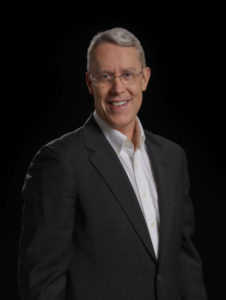
GSSI, the world’s leading manufacturer of ground penetrating radar (GPR) equipment, is pleased to announce the promotion of David Cist to the position of Vice President of Research & Development. An exceptional leader and innovator, since 1996, Dr. Cist has helped GSSI to develop several key products, including an arrayed utility mapper and a series of search and rescue tools.
Promoted from “Chief Geek” in 2015, and more recently to interim Director of R&D, Dr. Cist continues to provide the leadership GSSI needs to drive innovation and product strategy forward.
According to GSSI President, Chris Hawekotte, “I am pleased to announce the promotion of David Cist to the position of VP of Research & Development. David has led the organization in this capacity on an interim basis since last September and has convinced us that he is right to take on this role permanently. I am confident that he will continue to extend GSSI’s lead as the technological front-runner in GPR.”
A long-time GSSI employee, Dr. Cist recently celebrated his 21st year with the organization, having served in prior roles as Senior Software Engineer and also as Manager of Product Strategy and Planning. After graduating from Princeton University with a BSE degree in Electrical Engineering and Computer Science, Dr. Cist worked in market research and then in R&D for Siemens Medical in Germany. There he developed the first ever voice recognition tool for cardiac catheterization procedures. Dr. Cist completed his education at Massachusetts Institute of Technology, with a Master’s degree in Radiology Science (Simulated Annealing image reconstruction), and finally a PhD in Geophysics (3D Migration of GPR data).
GSSI is confident Dr. Cist’s new position as technical lead will foster innovative solutions that further extend GSSI’s flagship role in the GPR industry.
Industry News, trenchless products
Armadrillco High-Flow/Side-Load Housing Adapted to the RockEye
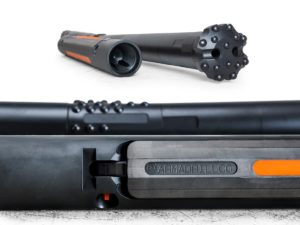 (Hutchinson, Kansas) – The spring 2017 acquisition of Armadrillco® solidified StraightLine HDD’s position as a leader in hard condition tooling. The announcement today of the adaption of the patented Armadrillco transmitter housing to the RockEye® Hammer System is a significant step in diffusing Armadrillco technology throughout StraightLine HDD tooling platforms.
(Hutchinson, Kansas) – The spring 2017 acquisition of Armadrillco® solidified StraightLine HDD’s position as a leader in hard condition tooling. The announcement today of the adaption of the patented Armadrillco transmitter housing to the RockEye® Hammer System is a significant step in diffusing Armadrillco technology throughout StraightLine HDD tooling platforms.
Adapting Armadrillco side-load housing technology gives users easy access to electronics, larger capacity fluid/air passages and improved durability. The housing’s patented Arma-Loc® system is a field-proven design that gives users quick access to electronics by virtue of removing a single pin. Free from threads, the Arma-Loc system virtually eliminates problems associated with damaged or over-torqued bolts, as well as vibration-induced lid failure.
The industry’s most secure lid retention system is also the most protected. Working in tandem with the Arma-Loc lid security system, a patented urethane and O-ring system is designed to seal and protect the sonde cavity from fluid/debris infiltration. The system also forms a cushioned platform that shields valuable electronics from punishing vibration and heat produced by a hammer working in harsh rock environments.
Large internal passages, up to 1-inch in diameter, represent a significant improvement in air/fluid flow. The larger passages are capable of delivering air volume up to 1,200 CFM and fluid volume of 300+ GPM.
Visit www.straightlinehdd.com and www.sourcehdd.com for more information.
Industry News, trenchless people
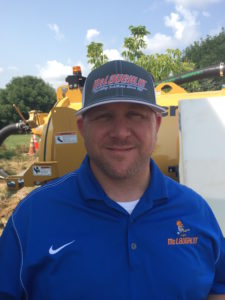 Company hires Cory Lee as regional sales manager
Company hires Cory Lee as regional sales manager
GREENVILLE, S.C. — August 8, 2017 — McLaughlin is proud to welcome its newest employee, Cory Lee, who is joining the team as a regional sales manager serving all McLaughlin customers in the Southwest region.
Lee brings over 15 years of sales knowledge and 5 years of management experience to his new role, including a management position at Vermeer. Lee used innovative sales tactics to pursue new leads while maintaining strong relationships with existing customers as a territory sales manager and solutions specialist at Vermeer.
“With his prior field experience at Vermeer, his familiarity with the underground construction industry and his proven sales record, Cory is a fantastic addition to the McLaughlin team,” said Jeff Wage, vice president of McLaughlin. “His willingness to go above and beyond for customers combined with his exceptional sales and management expertise will allow him to bring the highest level of support to the Vermeer dealers in his region.”
McLaughlin is a leading manufacturer of trenchless construction equipment including auger boring machines, Vermeer-branded vacuum excavators and pneumatic piercing tools, as well as locators, directional drills and various attachments. Lee’s role will be to support the full line of McLaughlin products to dealers and customers.
For more information on McLaughlin products and services, visit the company’s website at www.mclaughlinunderground.com or email McLaughlin at mmole@mightymole.com.
Industry News, trenchless projects
Irrigation and Hydroelectric Project to Ease Food Crisis in Mid-Western Region of Nepal
 Nepal will welcome its first TBM ever this summer, a 5.06 m (16.6 ft) diameter Double Shield machine for the Bheri Babai Diversion Multipurpose Project (BBDMP). The Robbins TBM underwent its Factory Acceptance Testing in July 2017 and is currently being shipped to the jobsite in the Siwalik Range, part of the Southern Himalayan Mountains. Pre-construction, including laying gravel onto rural roads and excavating wells for drinking water, has been completed to make way for the TBM and its impending launch.
Nepal will welcome its first TBM ever this summer, a 5.06 m (16.6 ft) diameter Double Shield machine for the Bheri Babai Diversion Multipurpose Project (BBDMP). The Robbins TBM underwent its Factory Acceptance Testing in July 2017 and is currently being shipped to the jobsite in the Siwalik Range, part of the Southern Himalayan Mountains. Pre-construction, including laying gravel onto rural roads and excavating wells for drinking water, has been completed to make way for the TBM and its impending launch.
The BBDMP is one of Nepal’s 11 National Pride Projects–prioritized plans sanctioned by the Government of Nepal to further develop the mainly rural country. This project will irrigate 60,000 hectares (almost 15,000 acres) of land in the southern region of Nepal, benefitting an estimated 30,000 households. It will divert 40 cubic meters of water (1,400 cubic feet) per second from Bheri River to Babai River under a head of 150 m (492 ft) using a 15 m (49 ft) tall dam, providing year-round irrigation in the surrounding Banke and Bardia districts. The water will also be used for hydroelectricity, with a generating capacity of 48 MW benefiting the country with NPR 2 billion (20 million USD) annually.
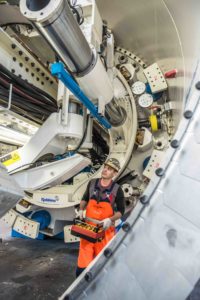 Contractor China Overseas Engineering Group Co. Ltd. Nepal Branch (COVEC Nepal Branch), represented by China Railway No.2 Engineering Co., Ltd Chengtong Branch, is responsible for the headrace tunnel and is aware of the challenges associated with tunneling in tough geology. “The design of Robbins TBMs is good, and in particular Double Shield TBMs,” said Project Manager of BBDMP, Hu Tianran, for China Railway No.2 Engineering Co., Ltd Chengtong Branch. The Siwalik range is projected to consist of mainly sandstone, mudstone and conglomerate, requiring a TBM that can withstand squeezing ground, rock instability, possibly high ingress of water and fault zones. Maximum cover above the tunnel is 820 m (0.5 mi).
Contractor China Overseas Engineering Group Co. Ltd. Nepal Branch (COVEC Nepal Branch), represented by China Railway No.2 Engineering Co., Ltd Chengtong Branch, is responsible for the headrace tunnel and is aware of the challenges associated with tunneling in tough geology. “The design of Robbins TBMs is good, and in particular Double Shield TBMs,” said Project Manager of BBDMP, Hu Tianran, for China Railway No.2 Engineering Co., Ltd Chengtong Branch. The Siwalik range is projected to consist of mainly sandstone, mudstone and conglomerate, requiring a TBM that can withstand squeezing ground, rock instability, possibly high ingress of water and fault zones. Maximum cover above the tunnel is 820 m (0.5 mi).
Due to the challenges in the young geology of the Himalayas, Difficult Ground Solutions (DGS) have been incorporated into the machine’s design. A stepped shield has been designed to move through squeezing ground. Robbins Project Engineer Missy Isaman talked about the DGS features incorporated into the TBM: “There is a probe drill in the rear that probes through the gripper shield in 14 places. We added ports in the forward shield for drilling too. There are eight ports around the circumference for hand drilling. There are also six ports in the top 100 degrees of the shield for forepoling.” She further noted that no equipment was ordered for either of the forward shield drilling options, but it’s easier to add the ports to the shield now, in case more comprehensive drilling is needed later in the bore. Other machine modifications included 35 mm (70 mm on the diameter) of possible overcut for gage cutters, and additional ports in the forward shield for dewatering.
Muck removal will be achieved by muck cars. Robbins will provide Field Service to support the machine erection, testing, commissioning and boring of the first 500 m (1,640 ft). The tunnel will be lined with hexagonal precast concrete segments.
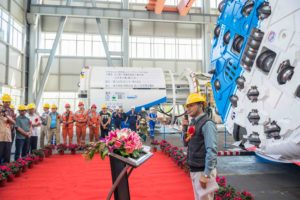 The project owner, the Government of Nepal’s Ministry of Irrigation (MOI), has chosen a TBM over the traditional method of Drill &Blast due to the faster mobilization and rate of advance offered by mechanized mining. “The reason a TBM was chosen for this project was because using D&B method could have taken at least 12 years for project completion. This was due to there only being one excavation heading with no possibility of launching multiple operations using adit tunnels,” said Robbins General Manager for Nepal, Prajwal Man Shrestha. More generally, Mr. Shrestha saw the project as a way to prove that TBMs can indeed take on complex Himalayan rock. “Since the Himalayan range has a young geology and not much has been surveyed yet, the use of newer technology is looked upon with slight apprehension. The first few TBM projects and additional surveys will show how suitable TBM technology will be for the Himalayan Range.”
The project owner, the Government of Nepal’s Ministry of Irrigation (MOI), has chosen a TBM over the traditional method of Drill &Blast due to the faster mobilization and rate of advance offered by mechanized mining. “The reason a TBM was chosen for this project was because using D&B method could have taken at least 12 years for project completion. This was due to there only being one excavation heading with no possibility of launching multiple operations using adit tunnels,” said Robbins General Manager for Nepal, Prajwal Man Shrestha. More generally, Mr. Shrestha saw the project as a way to prove that TBMs can indeed take on complex Himalayan rock. “Since the Himalayan range has a young geology and not much has been surveyed yet, the use of newer technology is looked upon with slight apprehension. The first few TBM projects and additional surveys will show how suitable TBM technology will be for the Himalayan Range.”
The success of the BBDMP, a national pride project, is paramount for the country as well as the TBM industry. It is expected to help aide the food crisis in the mid-western region of Nepal by increasing agricultural yields and invigorating socio-economic development in the region. The Robbins TBM for the 12.2 km (7.5 mi) tunnel is scheduled to launch in November 2017.
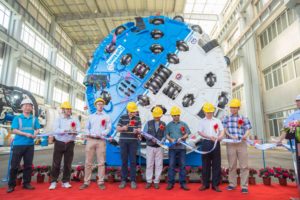 Image 1: The 5.06 m (16.6 ft) diameter Double Shield TBM will bore a 12.2 km tunnel from the Bheri River to Babai River.
Image 1: The 5.06 m (16.6 ft) diameter Double Shield TBM will bore a 12.2 km tunnel from the Bheri River to Babai River.
Image 2: Due to the geological challenges in the Himalayas, DGS features have been added to the machine including a stepped shield, and dozens of ports throughout the front, rear and around the circumference of the machine.
Image 3:. Mr. Saroj Chandra Pandit, Deputy Director General of DOI (Department of Irrigation) speaking at the Factory Acceptance Testing. Other speakers included Mr. Lin Qiang, Deputy Manager of China Railway No. 2 Engineering Co., Ltd and Mike Kolenich from Robbins.
Image 4: The Robbins crew, contractor COVEC Nepal Branch, and project officials stand proudly in front of the Robbins Double Shield TBM that will tackle the challenging geology in the Himalayas.
Industry News, trenchless people
 CALGARY, July 15, 2017 –CCI Inc., one of Canada’s Gold Standard Best Managed Companies http://ccisolutions.ca/ announces the acquisition of Houston based Horizontal Technology, Inc.
CALGARY, July 15, 2017 –CCI Inc., one of Canada’s Gold Standard Best Managed Companies http://ccisolutions.ca/ announces the acquisition of Houston based Horizontal Technology, Inc.
CCI Inc. is a leading expert in Horizontal Directional Drilling (HDD), Open-Cut and Micro-Tunneling methods. Since 2004, CCI has established itself as a driving force in the continued advancement of trenchless pipeline systems and employ proven methods for tackling difficult crossings.
With over 100 years of combined service in the HDD industry, Horizontal Technology, Inc. leads the way as the HDD industry’s premier guidance service and down-hole tooling provider.
For more information, please contact David Dupuis, COO, CCI. Inc. at ddupuis@ccisolutions.ca or 403-932-0560.
 THOMPSON, CONNECTICUT USA, August 31, 2017:
THOMPSON, CONNECTICUT USA, August 31, 2017:















